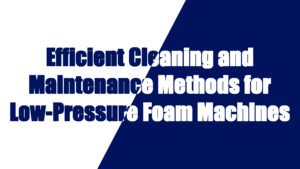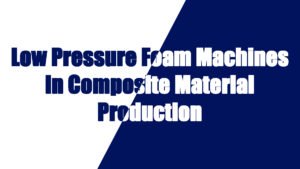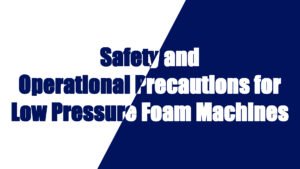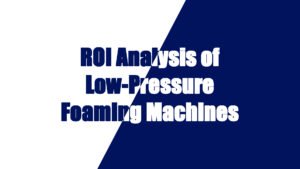Elastomer casting equipment may experience various malfunctions during long-term operation, and if not addressed properly, these issues can affect product quality, production efficiency, and even result in downtime. Timely and effective troubleshooting is essential to ensure the continuous operation of elastomer production lines. This article will discuss the common causes of malfunctions, provide detailed troubleshooting steps, and offer solutions to help users quickly diagnose and repair issues to maintain smooth production.
Common Failures in Elastomer Equipment
Uneven Mixing
Symptoms:
- The product surface shows uneven colors or spots, which affects the appearance of the final product.
- The density distribution of the elastomer is uneven, leading to performance inconsistencies such as varying strength and elasticity.
Main Causes:
- Inaccurate Raw Material Proportions: Incorrect A/B component ratios cause incomplete chemical reactions.
- Clogged or Worn Mixing Head: Obstruction or wear in the mixing head prevents proper blending of materials.
- Faulty Mixing Device: Low stirring speeds or damaged stirring blades reduce mixing efficiency.
Insufficient or Unstable Injection Volume
Symptoms:
- Inadequate mold filling, resulting in defects such as bubbles and voids.
- Inconsistent injection volume, causing fluctuations in the production process that negatively impact product quality.
Main Causes:
- Metering Pump Failure or Wear: Worn or damaged seals in the pump body lead to unstable flow rates.
- Clogged Pipelines: The mixing system’s pipelines may be obstructed by debris or hardened materials, preventing proper material flow.
- Low Raw Material Pressure: Insufficient air pressure in the storage tank or instability in the pumping system pressure leads to inadequate material supply.
Abnormal Temperature Control
Symptoms:
- Excessively high or low temperatures, resulting in reduced production efficiency or safety hazards.
- The material temperature fails to reach the preset value, which affects the chemical reaction and leads to unstable product quality.
Main Causes:
- Faulty Temperature Controller: The temperature controller malfunctions or fails to maintain accurate readings.
- Heating System Issues: Worn-out heating elements or poor connections result in low heating efficiency.
- Clogged Cooling System: Blocked cooling pipes hinder the efficient removal of heat from the system.
Automation System Failure
Symptoms:
- The control system is non-functional, preventing the setting or adjustment of production parameters.
- The operation interface displays error messages, and production data cannot be recorded or retrieved.
Main Causes:
- Software or Program Errors: The control system encounters errors, preventing parameter input or adjustments.
- Electrical System Issues: Aging wiring, poor connections, or power fluctuations interfere with the equipment’s operation.
- Sensor Malfunctions: Faulty sensors cause abnormal data transmission, resulting in inaccurate feedback to the system.
Troubleshooting and Solutions
Solutions for Uneven Mixing
Troubleshooting Steps:
- Check Raw Material Proportions: Use precise electronic scales or automatic batching systems to verify that the A/B component ratio meets the specified requirements.
- Disassemble the Mixing Head: Inspect the mixing head for blockages or residue buildup. Clean the mixing head with solvent if necessary.
- Inspect the Mixing Device: Use a tachometer to check the mixing device’s speed. Verify that the stirring blades are not damaged or worn and replace them if needed.
Optimization Measures:
- Install Inline Sensors: Real-time monitoring of mixing uniformity can automatically adjust stirring speeds to maintain consistent mixing quality.
- Regular Calibration: Regularly calibrate the mixing system to ensure long-term stable operation.
Solutions for Insufficient or Unstable Injection Volume
Troubleshooting Steps:
- Inspect the Metering Pump: Disassemble the metering pump to check for wear or damage. Ensure that the flow rate is stable and conforms to specifications.
- Clean the Pipelines: Disassemble and clean the pipes and filters to remove debris and hardened material, ensuring smooth flow.
- Check the Pressure System: Verify that the storage tank pressure is adequate and ensure the stability of the pressure in the pumping system.
Optimization Measures:
- Regular Metering Pump Maintenance: Periodically inspect the metering pump, clean it of contaminants, and replace any worn-out parts.
- Install High-Precision Flow Meters: Real-time flow rate monitoring and parameter adjustments help ensure stable material injection.
Solutions for Abnormal Temperature Control
Troubleshooting Steps:
- Test the Temperature Controller: Use a temperature testing device to verify that the actual temperature matches the preset temperature. Replace the temperature controller if needed.
- Inspect the Heating System: Check the resistance of heating elements and ensure that the heating tubes are not worn out or damaged.
- Inspect the Cooling System: Check the flow of cooling fluid and clean the cooling pipes to ensure optimal heat dissipation.
Optimization Measures:
- Install Temperature Alarms: Set up temperature alarm devices to alert operators immediately if the temperature exceeds preset limits.
- Regularly Replace Coolant: Replace cooling fluid at regular intervals to maintain high cooling efficiency and prevent system overheating.
Solutions for Automation System Failures
Troubleshooting Steps:
- Restart the System: Restart the system to resolve software errors and reload the program to check for functionality.
- Replace the Sensors: Replace malfunctioning sensors to restore normal system operation.
- Inspect the Electrical System: Check the wiring and ensure that the electrical connections are secure and stable to avoid interruptions caused by power fluctuations.
Optimization Measures:
- Regular Software Updates: Regularly update the control system software to ensure it can handle new production requirements.
- Install Redundant Control Systems: Equip critical points with redundant sensors or backup control systems to ensure uninterrupted operation in case of failure.
Daily Maintenance and Care Recommendations
To extend the lifespan of elastomer equipment and reduce the frequency of failures, regular maintenance and care are essential. The following practices are recommended:
- Regularly Check and Replace Parts: Check components such as metering pumps, mixing heads, and heating elements for wear and tear, replacing them as necessary.
- Routine Equipment Cleaning: Clean equipment thoroughly after each production run to prevent material buildup and ensure optimal performance.
- Maintain Equipment Records: Keep detailed records of equipment operation and maintenance to analyze failure causes and optimize future maintenance.
- Operator Training: Provide regular training for operators to ensure they are proficient in equipment operation and can quickly address any issues that arise.
Through detailed troubleshooting and solutions, companies can significantly reduce production downtime and quality issues caused by equipment malfunctions. Timely troubleshooting and maintenance not only improve production efficiency but also extend the service life of the equipment. With the ongoing development of smart and automated systems, companies can better manage equipment, enabling smoother and more efficient production processes.




































